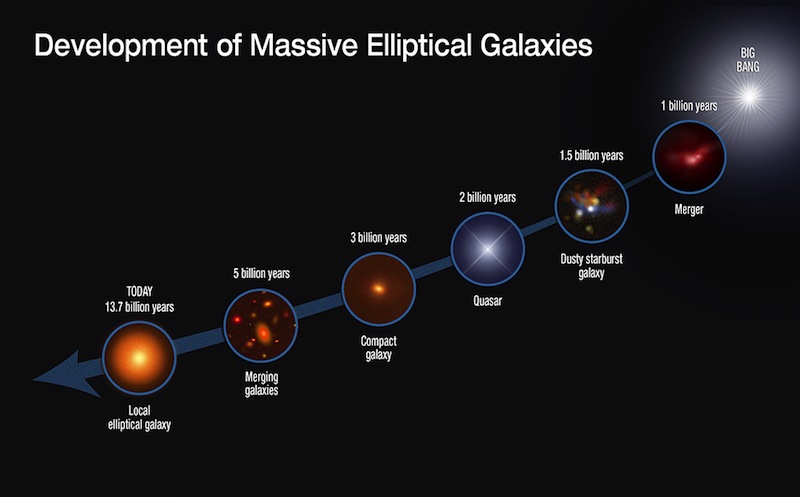Hubble Telescope Helps Solve Mystery of Universe's Massive Galactic Burnouts

Using data from the Hubble Space Telescope and other observatories, astronomers are learning why some massive galaxies hit their peak young and quit making stars when the universe was less than a quarter of its current age.
Scientists have been puzzled by compact, elliptical-shaped galaxies that seem to have burned out when the universe was 3 billion years old. For comparison, our Milky Way galaxy is 12 billion years old and still making stars. These burnouts are sometimes nicknamed "red and dead" galaxies because of their reddish color, compared to the blue hues of star-making galaxies, according to NASA. Strangely, these dead galaxies are just as massive as today's large spiral galaxies, but with stars squeezed into an area three times smaller.
"This means that the density of stars was 10 times greater," Sune Toft, an astrophysics and cosmology professor at the Niels Bohr Institute in Copenhagen, explained in a statement. "Furthermore, the galaxies were already dead, so they were no longer forming new stars. It was a great mystery." [Celestial Photos: Hubble Space Telescope's Latest Cosmic Views]
These burnouts appear to have started out as intense starburst galaxies in the very early universe, quickly gobbling up all the gas around them before fading, Toft and colleagues found.
To piece together a life history of the "red and dead" galaxies, the scientists looked at infrared data from space-based telescopes and ground-based telescopes, as well as two Hubble surveys. One was the Cosmic Assembly Near-Infrared Deep Extragalactic Legacy Survey, or CANDLES, which probes distant objects to help astronomers understand how galaxies, black holes and supernovas formed in the early universe. The other was 3D-HST, a near-infrared spectroscopic survey.
The burnouts shared characteristics with dust-shrouded galaxies that were rife with violent starburst activity and 1 billion to 2 billion years older, the scientists found. These live-fast-die-young galaxies seem to quickly use up available gas for star formation and burn out. Through merging, they eventually grow into giant elliptical galaxies in our local universe.
"We at last show how these compact galaxies can form, how it happened, and when it happened," Toft said. "This basically is the missing piece in the understanding of how the most massive galaxies formed, and how they evolved into the giant ellipticals of today."
Breaking space news, the latest updates on rocket launches, skywatching events and more!
The Hubble Space Telescope is a joint project between NASA and the European Space Agency. It launched into orbit in 1990 aboard the space shuttle Discovery.
The new research is detailed online in The Astrophysical Journal.
Follow Megan Gannon on Twitter and Google+. Follow us @SPACEdotcom, Facebook or Google+. Originally published on Space.com.

Megan has been writing for Live Science and Space.com since 2012. Her interests range from archaeology to space exploration, and she has a bachelor's degree in English and art history from New York University. Megan spent two years as a reporter on the national desk at NewsCore. She has watched dinosaur auctions, witnessed rocket launches, licked ancient pottery sherds in Cyprus and flown in zero gravity on a Zero Gravity Corp. to follow students sparking weightless fires for science. Follow her on Twitter for her latest project.
![Find out how Hubble has stayed on the cutting edge of deep-space astronomy for the past 20 years here. [See the full Hubble Space Telescope Infographic here.]](https://cdn.mos.cms.futurecdn.net/qK2xWDesnWUEsoFccAR7pM.jpg)

